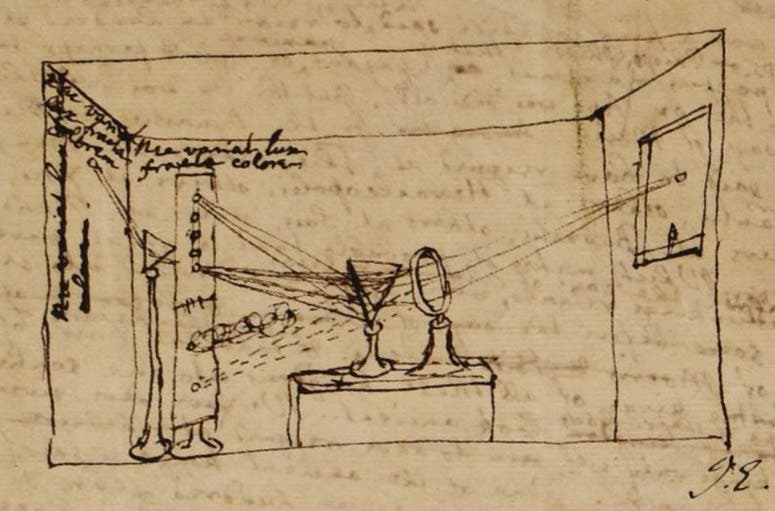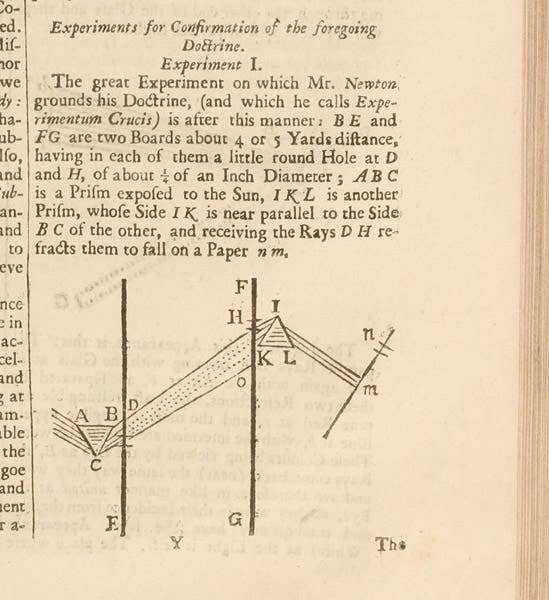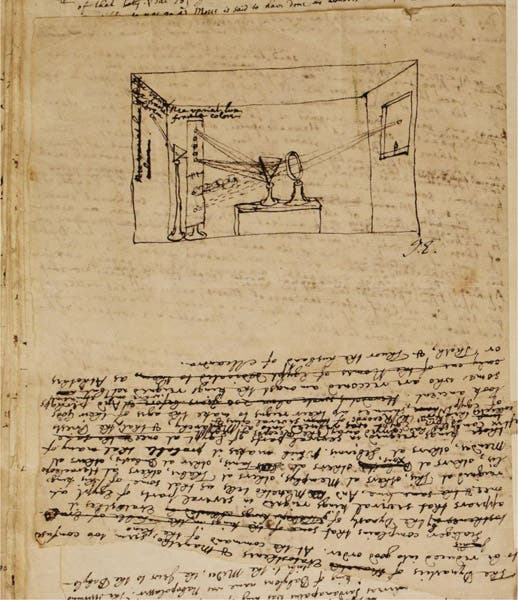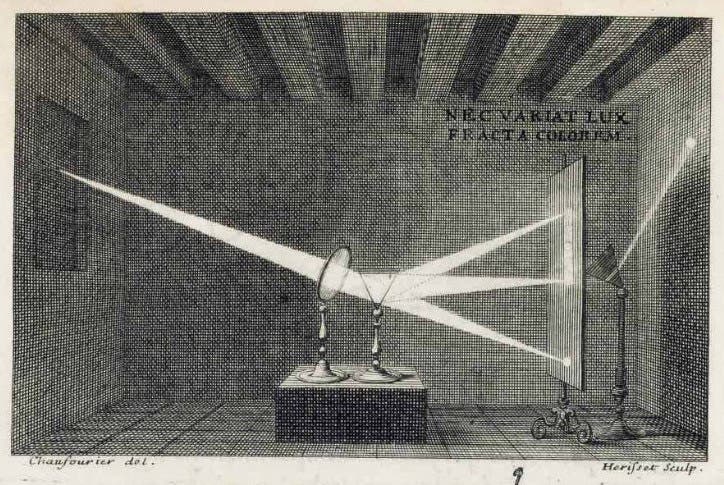Scientist of the Day - Isaac Newton
Since Dec. 28 has only a few good anniversaries, and we have already written about all of those, we thought we would go back a few days and celebrate someone born on Christmas Day. Because the Library is closed on Christmas, and we do not publish a Scientist of the Day, those with Christmas birthdays rarely get their moment in the Sun, at least not on their birthday. So today we make an exception and honor a Christmas birthday. And the most famous of all Christmas baby scientists is Isaac Newton. Granted, we list his birthday now as Jan. 4, 1643, but in Newton' modest household, he came into the world on Dec. 25, 1642, since England had not yet adopted the Gregorian calendar, and would not do so until long after Newton's death in 1727.
Surprisingly, Newton has been our Scientist of the Day only once, and that was way back on Jan. 4 (his recalibrated birthday), 2016, when we focused our brief discussion on the concept of universal gravitation, as introduced in Newton’s Principia of 1687. Here is a link to that post. Today, I thought we might talk about one of his most discussed experiments, the experimentum crucis of 1666, with which Newton showed that white light is made up of an assortment of rays that are "differently refrangible" (are bent at different angles by a prism), and that these variously refrangible rays have different colors.
Newton engaged in his investigations with sunlight and several prisms in the spring of 1666, when Cambridge was closed because of the plague and he was back at the family house in Woolsthorpe, Lincolnshire. He would describe the experiments in his very first published paper, in the Philosophical Transactions of the Royal Society of London, on Feb. 19, 1671/72 (so designated because that February was the 11th month of 1671 in England, but the second month of 1672 on the Continent). The paper was called "New theory about light and colors" (third image).
Newton tells us in the papers that on a day in 1666, he darkened his room and made a pinhole in the window shade. He directed the resulting beam of light at a glass prism and noticed, as many had before him, that the prism produced a spectrum, which he could project onto a board, a stretched-out image with red light at one end and violet at the other, and with orange, yellow, green, and blue in between. The red rays were the least refrangible, meaning they were bent the least by the prism, while the violet rays were the most refrangible. Newton conjectured that the colored rays were already present in white light, as constituent parts, and the prism merely separated the parts. But it was also possible that the prism physically changed white light into colors, and that white light was not an amalgam of differently colored rays. To test his hypothesis, Newton devised a crucial experiment – he would direct one of the colored rays, say the red one, produced by the first prism, through a second prism. If the ray changed color again, then the prism was effecting the change. But if it stayed red, then the prism was not changing the light, but merely separating the pre-existing colored rays. And when Newton directed the red rays through a second pinhole, and then through a second prism, they remained red and underwent no further change. His hypothesis, at least in his eyes, was confirmed.
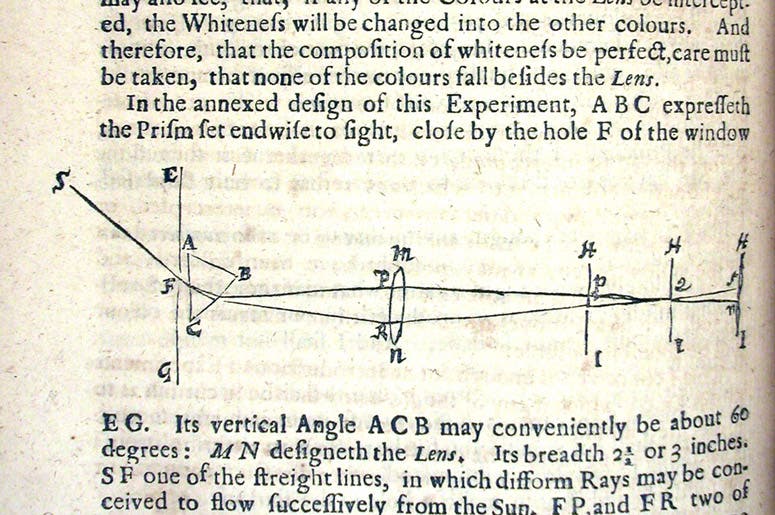
Diagram of an experiment with a prism and a lens (NOT the experimentum crucis), in Isaac Newton, “New theory of light and colors,” Philosophical Transactions of the Royal Society of London, Feb. 19, 1671/72 (Linda Hall Library)
The term experimentum crucis actually originated with Robert Hooke in 1666, without reference to Newton's experiment, and would seem to have its roots in several expressions of Francis Bacon, his “Instance of the Fingerpost” (instantia crucis) and his “Experiments of Light.” The first true experimentum crucis was that of Blaise Pascal, when, in 1648, he sent his brother-in-law up the Puy de Dôme with a Torricellian tube, to test his hypothesis that air has weight. But Newton's experiment with the two prisms has always been the classic example of an experimentum crucis, especially since he himself called it that.
Newton’s experimentum crucis has a less-than-spectacular graphic history. There is no diagram at all in Newton’s 1671/72 paper; the only diagram there shows a different experiment, in which he recombined the colored rays produced by a prism back into white light with a lens (fourth image), nor is there one in his later Opticks (1704). John Harris included a reasonably good diagram in his Lexicon technicum (1704); we showed it in our post on Harris, and again here (fifth image).
The most famous diagram of the crucial experiment is one made under Newton’s supervision more than 50 years after the experiment was first performed, in response to a request from Pierre Varignon, who was supervising the publication of a second French translation of Newton’s Opticks in 1722 (the first, in 1720, was very badly done). That drawing still survives in manuscript at New College, Oxford, and we show both a detail of the diagram (first image) and the entire page (sixth image). You will note that there is a lens present, so this does not show the original experiment of 1666 and 1671/72, but rather some later version. But Varignon was happy to have it, and he had it engraved for use as a headpiece for the Traité d’optique when it was published. We do not own the 1722 French edition, so we show the headpiece depicting the experimentum crucis as it appeared in a copy auctioned by Christie’s in 2010 (seventh image).
In our first post on Newton, we showed his portrait as painted by Godfrey Kneller in 1689, just after the Principia was published. For this occasion, we bring out Kneller’s second Newton portrait, this one painted in 1702, just after Newton had resigned his Lucasian professorship at Cambridge, was about to become president of the Royal Society, and was preparing his Opticks for publication. It hangs in the National Portrait Gallery in London (second image).
Now that we have made it through the Newton doldrums, we intend to discuss, as soon as occasion permits, his work on calculus and the feud with Leibniz; Newton’s inter-personal relations, or lack thereof; the apple-tree legend; and Newtonianism, as the 18th century conceived it. We may not get to all of these, but it seems like a credible goal.
William B. Ashworth, Jr., Consultant for the History of Science, Linda Hall Library and Associate Professor emeritus, Department of History, University of Missouri-Kansas City. Comments or corrections are welcome; please direct to ashworthw@umkc.edu.


